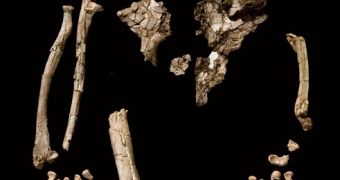When a team of scientists from the University of California in Berkeley discovered the Ardi skeleton in Ethiopia, back in 1994, the entire scientific community immediately started debating whether or not the ancient hominid was more closely related to humans than apes, or if the opposite is true.
New research from scientists at the Arizona State University (ASU) indicates that this was indeed the case, settling the decades-old argument. Ardi is the common name given to a hominid species that lived in Africa around 4.4 million years ago, which was called Ardipithecus ramidus.
When unearthed, Ardi displayed the most complex fossilized remains of any ancient hominid species, boasting no less than 110 different pieces of bone. The skeleton was much more complex and complete than the one belonging to the Lucy individual from the Australopithecus afarensis species.
Over the years, scientists were able to determine that Ardi was a woman weighing about 50 kilograms (110 pounds), who had significant human traits, such as small canine teeth, an upper pelvis modified for walking on two feet, and grasping big toes. The specimen's skull also featured a small brain.
Immediately after the species was found, researchers tried to determine if the species is closer to human than apes, or vice-versa, but the complex characteristics of the individual did not allow for a quick answer to this question. The new ASU study may provide the arguments needed to settle this debate.
Paleoanthropologist William Kimbel argues in the new research that Ardi had much closer evolutionary relationships with humans than with apes, meaning that its bodily traits were not simply a remnant inherited from the last common ancestor of humans and primates, which lived 8 million years ago.
For this investigation, the ASU team investigated the base of the Ardi skull, and determined that the patterns present here make the hominid a closer relative to Australopithecus afarensis than any ape.
“Given the very tiny size of the Ardi skull, the similarity of its cranial base to a human’s is astonishing,” says Kimbel, who holds an appointment as the director of the Institute of Human Origins at the ASU College of Liberal Arts and Sciences.
Details of the research were published in the latest online issue of the esteemed scientific journal Proceedings of the National Academy of Sciences (PNAS). Experts from the University of Tokyo Museum, the Rift Valley Research Service in Addis Ababa, the Tel Aviv University, and the University of California at Berkeley were also a part of the study.
“The Ardi cranial base fills some important gaps in our understanding of human evolution above the neck. But it also opens up a host of new questions […] just as it should!” Kimbel concludes.

 14 DAY TRIAL //
14 DAY TRIAL //